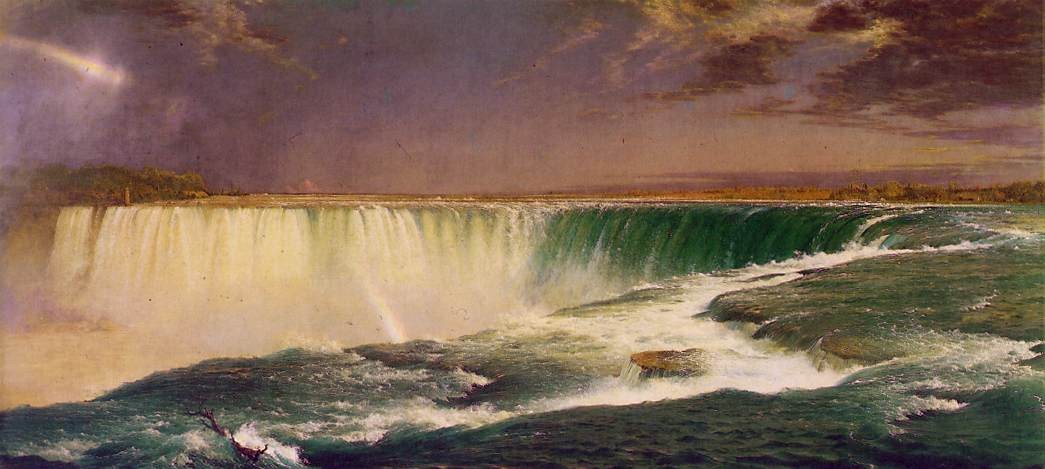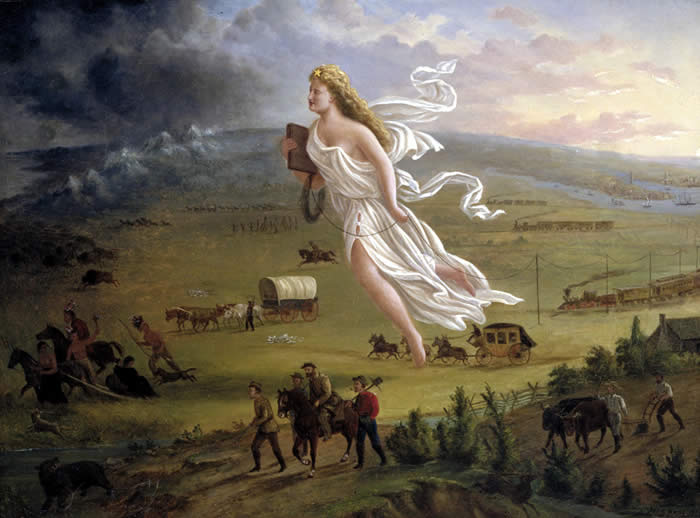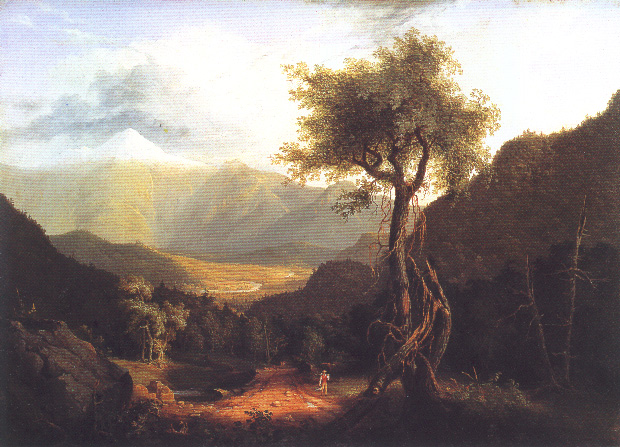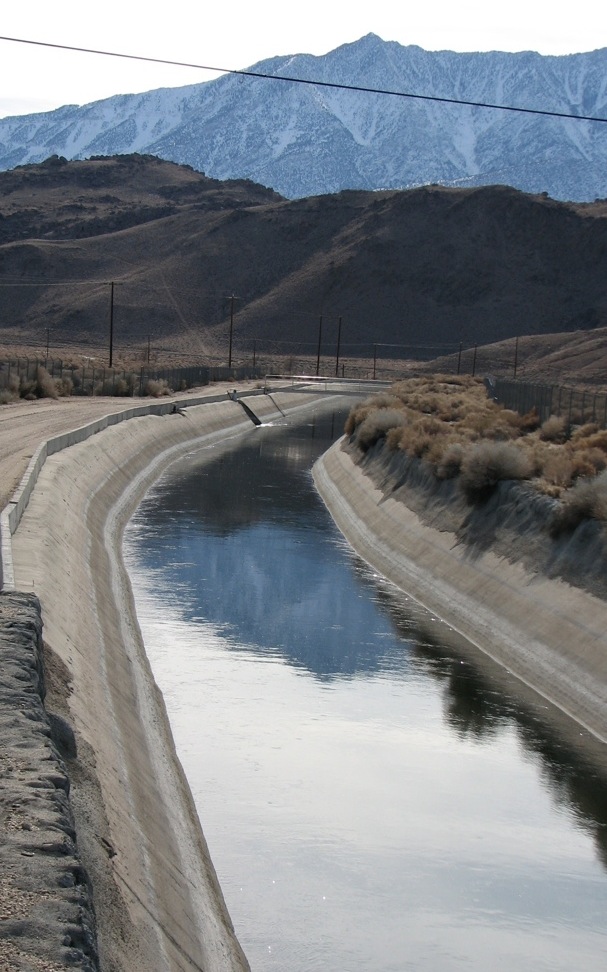October | November | December
 |
 |
| Niagara Falls, by F. Church, Oil on Canvas, American 19th century. | Westward the Course of Empire, by Currier & Ives lithograph, American 19th century. |
The American experience is misunderstood. Instead of a heroic, bullshit history –filled with crap–, American history is more like a a varied quilt, if not a perfected tapestry of designs, because the quilt pattern was born of different ethnic people and their need to settle a physiographically diverse, challenging and not-well-understood continent, by settlers of an explicitly different ethnic ancestry, who inhabited often distant outposts, and were not well connected to new trading posts linking them to the commercial networks of Europe, Asia, and Africa.
As the landscape was settled, the terrain was transformed. Land, air, and water were all converted to commercial advantage by extractive, industrial, transportation or residential uses. Wildlife, fisheries and and non-game species were affected by grazing, timber, and plantation agriculture, in addition to settlements. From this transformation a new set of perceptions, ideologies and values arose that led to preservation, conservation and protection of the health and ecology of the nation.
This course is about that story of conquest, dispossession, scenic monumentalism, commercial use, and regeneration of our cultural geography.
Thomas Cole, 1827, The White Mountains, New Hampshire: an indication of the national identification and fascination with land and its features.
ROLLINS COLLEGE
Environmental History is the study of how settlements –especially land use – alter ecological conditions and how those changes influence each era’s ideas about nature with respect to responsible resource use from one period to the next.
American Environmental history on-line
Joseph Vincent Siry, Ph.D.,
U.C. Santa Barbara. Emory
University. & Washington & Lee University.
Office: Beale Building –Park Ave. side–
room 105.
Web site: http://myweb.rollins.edu/jsiry
The terms of the syllabus are subject to changes announced in class.
Calendar of this course ENV-380.01
Search here:
 Under development
Under development
August | September | October | November | December
Calendar
Tentative Course Schedule [requires students to keep a (wiki) journal]:
(May change to accommodate guest presenters & participating students' needs)
Dates topics readings assignments
August
23 Voices of the past; voices from your past?
25 Crosby, Germs, Seeds, & Animals -- selection
September
See this page for the week's notes.
1 Du Bois, The Souls of Black Folks, Chapter 7. Questions, see: Souls
3 Emerson, Nature.
See this page for this week's focus, themes, photographs, and suggestions:
8 Siry, pp. 3-33, focus on A Frontier
10 Comparing five points of view to your own: Tell us who you are and what struck you as important in Crosby, Du Bois & Emerson.
Post your writing to this wiki.
15 Siry, pp. 34-82
17 Legacy of the Naturalists compared to the pioneers on the frontier
Post your writing to this wiki.
22 Siry, pp. 83-156
24 The Emergence of Science
29 Siry, pp. 157-191
October
1 The consequences of ecology: a contingent and synthetic science
6 Reports
8 Fall break, no class.
13 Ecology
15 Revising essays Coherent Paper exercise
20 Settling the high frontier Egan, pp. xi - 58
|
... evidence | conservation | means | 80 million acres lost | review | contents ..... The Worst Hard Time depicts physical hardship on a larger scale than anything in ...
https://myweb.rollins.edu/.../The%20Worst%20Hard%20Times.html
|
22 Learning lessons about land. Egan, pp. 59-135
|
Z-A site contents .... "Dust Bowl" was a term used by a reporter to depict hard times and displaced people who lived in the .... "The Worst Hard Times" ends before this failure, but not before Egan, in an epilogue, gets in a quick dig against ...
https://myweb.rollins.edu/.../The%20Worst%20Hard%20Times2.html
|
27 Land & landscape Finish Egan, pp. 59-135 & Start Egan, pp. 136-197
|
Z-A site contents ... "The worst thing was the wind. ... For other lands the ground could be seeded, and in time the southern plains would have its grasslands back ...
https://myweb.rollins.edu/.../The%20Worst%20Hard%20Times3.html
|
29 The Consequences of misfortune and climate. Egan, pp. 136-197
|
USDA History of the dust bowl. book Contents. Readings. learn Clarify. learn ... The Worst Hard Times: One: Paradox | Two: Folly & Fix | Three: Sensory reality.
https://myweb.rollins.edu/jsiry/WorstHardTimes_Notes9-16.html
|
November
3 What were the causes of this dust bowl? Egan, pp. 198-272
|
NASA MPEG · Book. Contents · The Worst Hard Times · The Worst Hard Times II · The Worst Hard Times III. Physical realities. The Taylor Grazing Act, 1934 & the ...
https://myweb.rollins.edu/jsiry/Droght_Dust-bowl.html
|
5 What were the causes of this dust bowl?
|
Book Timothy Egan, The Worst Hard Times, book. Contents. PROMISE 1901- 1930 | BETRAYAL, 1931-1933 | BLOWUP, 1934-1939 | Epilogue. April 14 –80th ...
https://myweb.rollins.edu/.../Egan_Worst_Hard_Times-Contents.htm
|
10 What conservation measures were developed to deal with the problem? Egan, pp. 273-314
|
"consider the weightiest problem now before the Nation; and the occasion for the meeting lies in the fact that the natural resources of our country are in danger of ...
https://myweb.rollins.edu/jsiry/Conserv-versus-Preserv.html
|
12 What conservation measures were developed to deal with the problem? Continuing the discussion of Egan, pp. 273-314
|
Adam Rome,. Bulldozer in the Countryside. "The postwar decades thus suggest the weakness of consumer driven environmentalism. . . .the nation's consumers ...
https://myweb.rollins.edu/jsiry/Bulldozer_in_Country-3.html
|
17 What happened to the countryside? Rome, pp. 1-118
|
"In 1950....Four of Garnett's images became iconic. The first was a bulldozed landscape....In the second photograph, the tract had dozens of foundations in lines ...
https://myweb.rollins.edu/jsiry/Bulldozer_2001.html
|
19 How did several different factors contribute to the urban revolution to suburbia? Rome, pp. 1-118
|
There are, as outlined in the Adam Rome book, steps that federal policy took enabling the 1945 to 2005 boom in suburban housing. The costs directly were a ...
https://myweb.rollins.edu/jsiry/Bulldozer_in_Country.html
|
24 Rome, pp. 119-188: What defines suburbia?
|
Adam Rome. The Bulldozer in the Countryside: Suburban Sprawl & the Rise of American Environmentalism. “The environmental cost of home building rose ...
https://myweb.rollins.edu/.../Bulldozer%20in%20the%20Countryside.htm
|
26 Thanksgiving break, no class.
|
Write for five minutes on what Adam Rome means by: “The purchase of a house is never simply a matter of cost." “reason for the limited success of efforts to ...
https://myweb.rollins.edu/jsiry/Gospel_Ecology-Rome-Bull-4.html
|
3 reports
|
What | When | Where | How | Housing boom | Adam Rome's Argument | Sources ... Next. Adam Rome's history. book. Contents · Overview · Part One · Part Two.
https://myweb.rollins.edu/jsiry/Conservation-waves-Homes.html
|
Final Exam is Tuesday, December 8 @ 8-10 a.m. See– http://www.rollins.edu/student-records/exam-schedule/index.html
Environment in the past–meaning the ecology, geography, and hydrology of our nation and its settlement–involves a most challenging of all historical policy subjects. For learners seeking lively challenges, studying America’s biota and land use may be a fulfilling inquiry because you will learn about our common natural and cultural heritage that informs today’s arguments over protection and use. Working together in this course we examine the subject's several layers by focusing specifically on questions that environmental history raises about the character of biomes, the relationship among nature, ethnic minorities on the land, and the moral imagination required to understand our place in the alterations of America’s landscapes, wildlife, watersheds, and economic geography.
calendar | requirements | competencies | texts | policies | grades
The course is designed for students to practice writing, so you need to arrive in class with four to six questions having read the assignments before our meeting so able to discuss our texts that you pose arguments the assigned readings raised. More practically, participants will have opportunities to hone their skills in reading analytically, in expressing your ideas verbally in a supportive setting, and in articulating your ideas in writing as we all learn throughout the term. Especially in our class, I would wish, now and again, you will experience the delight and enjoyment of being so stirred by the power of ideas and well-stated prose as to stimulate your spirits, to amend your behavior, or nourish your more curious sensibilities, and even move you to responsibly act as a means to improve our world.
Texts,
Mary
Austin, Land
of Little Rain
Joseph
Siry, Marshes
of the Ocean Shore
Timothy
Egan, The
Worst Hard Times
Adam
Rome, Bulldozer
in the Countryside
Some other authors (Carson, Galbraith, Leopold, Reisner) e-mail & website as assigned:
Emerson, Nature, Emerson II, Olmsted, Siry III, Worster, Merchant, Leopold II, Egan, Rome
Henry
David Thoreau, Civil Disobedience, The Thoreau Reader (on-line sources)
The Owen's Valley Aqueduct from Bishop to Los Angeles, California.
Grades:
all assignments are
graded with careful attention to each of these criteria: {CLIFS}
1.
C clarity,
conceptual coherence, spelling, grammar & logical consistency
2.
L length
& development of your arguments, evidence, examples, or presentations
3.
I informative
value from the class discussions, texts, library research, or interviews
4.
F frequency
of illustrations from the web site, lectures, journals, notes & readings
5.
S subjects
advanced as argued in a thesis, introduction, summaries, & conclusion.
Course focus––"What natural and cultural resources are worth protecting in America for the future?"
The names and phone numbers of two other
students in the class:
1. _______________________________ 2. _______________________________
What is environmental history and what are some of the sources to consider?
Opening Song Joni Mitchell: "Big Yellow Taxi," Lyrics: see www.songlyrics.com/joni-mitchell/big-yellow-taxi-radio-mix-lyrics/
"Shenandoah"
Aaron Copland, Applachian Spring
William Byrd, A History of the Dividing Line
Mary Austin, Land of Little Rain
John Kenneth Galbraith, The Great Crash
Secondary documents
Alfred Crosby: Germs, Seeds and Animals: Ecological History
Siry, Marshes of the Ocean Shore (terms defined)
Siry on the
Ralph Waldo Emerson, "Nature" (1836)
Henry David Thoreau, Civil Disobedience (1849)
Frederick Law Olmsted Sr. Journey ... Seaboard Slave States
FL0 go here for excerpts see there.
George Perkins Marsh, Man and Nature, (1864)
Timothy Egan, The Worst Hard Times
Adam Rome, Bulldozer in the Countryside
Rachel Carson, Silent Spring
Merchant | Worster | Cronin | Reisner | Jackson | Siry | Leopold | |Diamond | Williams | Austin | Mumford | Marx



